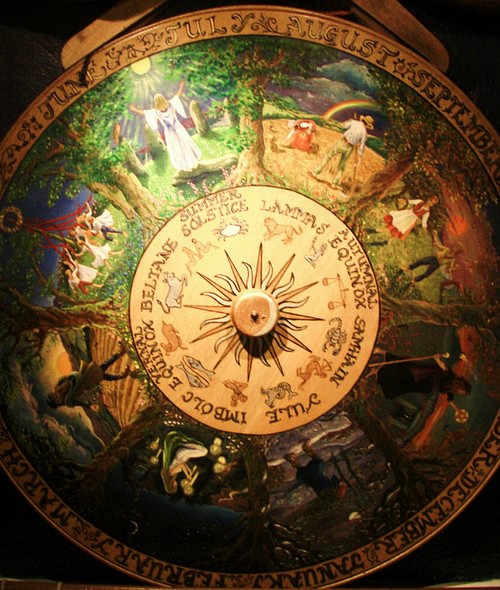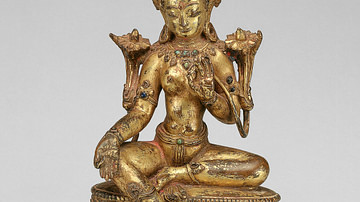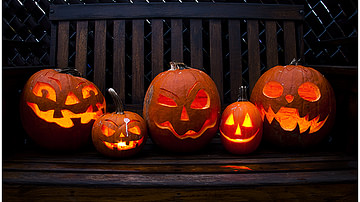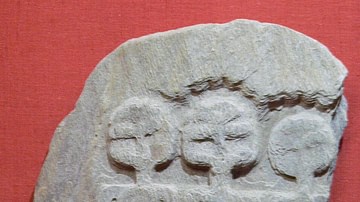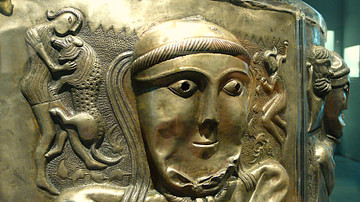
Samhain (pronounced “SOW-in” or “SAH-win”), was a festival celebrated by the ancient Celts halfway between the autumn equinox and the winter solstice. It began at dusk around October 31st and likely lasted three days. Samhain marked the transition between the year's lighter and darker halves and was celebrated throughout the ancient Celtic communities of Europe, including Ireland, Wales, and Scotland. Believed by the ancient Celts to be a liminal time when the veil between the human and spirit realms is lifted, Samhain is considered by many to be the precursor to contemporary Halloween celebrations. Samhain is also the modern Irish word for the month of November. In Ireland, the Hill of Ward in County Meath was the sacred site of the Samhain fire festival, and in recent years, people have gathered there on Halloween to participate in a modern-day Samhain revival.
The Pagan Festival
The ancient Celts divided the year into two halves, the lighter half and the darker half, and held four celebrations to mark the changing seasons:
- Imbolc - celebrated halfway between the winter solstice and the spring equinox
- Beltane - halfway between the spring equinox and the summer solstice
- Lughnasadh - halfway between the summer solstice and fall equinox
- Samhain - halfway between the fall equinox and winter solstice
Of these four sacred times, Samhain was perhaps the most significant as it is thought to have represented the Celtic New Year. For the ancient Celts, time began in darkness, with each 24-hour day commencing at dusk. Ushering in the darker half of the year, Samhain represented the end of one year and the beginning of the next.
With its origins in the pastoral calendar, Samhain celebrations likely pre-dated the arrival of the Celts in Ireland some 2,500 years ago. It was a time for making winter preparations; crops were harvested, and animals were rounded up from the fields either to be sacrificed or lodged for the winter and used for breeding. Feasts, abundant in both food and alcohol, were held to celebrate the harvest. Samhain was also a sacred time for assembling and for settling important business matters, such as the inauguration of new kings. Debts were repaid and trials for the more egregious crimes were held, with justice meted out accordingly.
The 17th century CE Irish historian, Geoffrey Keating, wrote in his seminal work, The History of Ireland, that all fires were to be extinguished at the start of the Samhain festival. The druids, the ancient Celtic priests, would light a new bonfire, into which the bones of the animal sacrifices would be tossed (this “bone-fire” gives us our modern word 'bonfire'). From this fire, others would light their torches and carry the flames home to relight their own hearths. Perhaps fittingly, much mystery shrouds the festival of Samhain from our modern vantage point. We cannot know for sure exactly what would have taken place, but historians believe the festivities included animal sacrifices, dancing, and the donning of costumes made from animal skins, and possibly, animal heads.
Samhain was considered an auspicious time for the druids to practice divination, since the connection to the spirit world was stronger than usual. The lifting of the veil between the Otherworld and the physical world meant that Samhain was also considered to be a perilous time for the ancient Celts. The Celtic Otherworld is often described as existing in tandem with, as opposed to completely separate from, the human world. During Samhain, these realms converged and passage between them was easier. Spirits, both kind and malevolent, could act with more powerful agency on the human world.
The concept of liminality, or “the in-between,” was an integral component of ancient Celtic spirituality, and many important events in Celtic mythology took place in liminal spaces, such as on the shoreline, or at liminal times, like dusk or dawn. Samhain did not simply mark the change from summer to winter but represented a transitional period in between the two seasons. Samhain was therefore without time, belonging to neither summer nor winter. The human realm was no longer bound by the rules of the physical world, and perhaps for this reason, Samhain is also thought to have been a time of peace. This was not the time for trivial human quarrels with the spirit realm in such close proximity.
Samhain in Celtic Mythology
Perhaps unsurprisingly, many important supernatural events described in Celtic mythology occur during the time of Samhain. The Second Battle of Moytura (Cath Maige Tuired), a pivotal moment in Irish mythology and one of the most important remaining medieval texts on the subject, was fought between the spiritual beings known as the Túatha Dé Danann and the Fomoire and is said to have taken place during Samhain.
It is also during this time that the aos sí (pronounced “EES SHEE”), magical beings (sometimes described as faeries, sometimes as Túatha Dé Danann who were driven underground, and sometimes, as the pre-Celtic inhabitants of Ireland) were known to pass freely from their Otherworld dwellings into the human realm. The aos sí, or “people of the hollow hills,” lived in sídh (pronounced “SHEE”) mounds, ancient burial mounds believed to be portals to the Otherworld. Once a year, on Samhain, these portals would open to the human world, and one could observe the fires lit within, and the sídh people coming and going.
Such is the case in the tale of the outlaw Fionn mac Cumhaill, a popular legendary figure in medieval Ireland. When Fionn was studying poetry with Cethern son of Fintan, he observed how once a year on Samhain, Cethern would journey to one particular sídh mound where the fairy Éle lived. She was rumored to be the most beautiful of all the fairies on the entire island of Ireland. She was also unimpressed by her plethora of suitors, and many men would lose their lives every Samhain in their foolish attempts to woo her. Fionn is disturbed by these deaths, and the following Samhain he hides in the valley near Éle's sídh mound to wait. In the darkness, he can see the sídh mounds aglow with firelight emanating from their doorways. According to the legend, Fionn is able to avenge the death of his friends and to win the respect of the fairies on this fateful night.
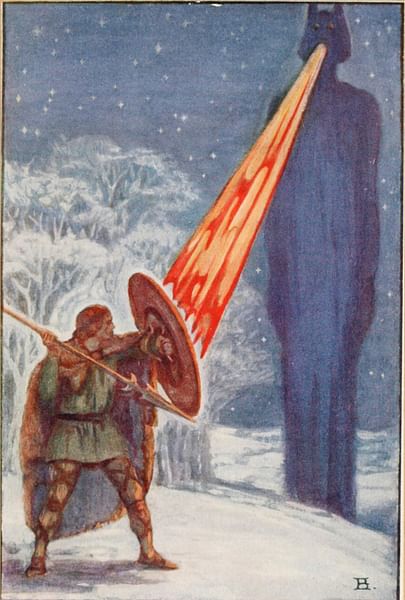
On Samhain, humans could travel to the sídh people, but the sídh beings could also walk in the physical world. Aillen, a sídh warrior, is said to have destroyed Tara, the spiritual center of Ireland and the seat of the High Kings, each and every Samhain for nine years. He is slain by none other than Fionn mac Cumhaill, who pierces him with an enchanted spear mere moments before Aillen can escape through the sídh mound back to the safety of the Otherworld.
Yet another legend tells of a girl named Caer Ibormeith, whose father is one of the Túatha Dé Danann. Every other Samhain, Caer transforms into a swan. Her suitor, Oenghus mac Oc, wishes to win her affection, but he knows he can only do this during Samhain, so he waits for the time of year when the rules of the physical world can be broken, and he is able to turn himself into a swan, as well. Though the written evidence for much of Irish mythology dates only as far back as medieval times, having been recorded by Christian monks who possibly tampered with their meanings, many of these legends are thought to have roots in pre-Celtic Irish spirituality.
The Hill of Ward & the Samhain Fire Festival
In Ireland, the ancient Celts celebrated the Samhain fire festival at the Hill of Ward, also known as Tlachtga, named for a powerful druidess who died there after giving birth to triplets. Located in the Boyne Valley in County Meath, Ireland, the Hill of Ward is approximately twelve miles from the Hill of Tara.
The Hill of Ward has received comparatively less attention than its more famous neighbors, such as Newgrange. Some archaeological studies of the site were conducted nearly a century ago in the 1930s CE, but it was not revisited again until 2014 CE when excavations led by Dr. Stephen Davis of the University College Dublin commenced. The team discovered that the Hill of Ward was likely constructed in three separate phases, the earliest dating to the Late Bronze Age around 1200 BCE, and the most recent dating to the early medieval period around 400 CE. Evidence of large-scale burning was found by archaeologists at the site, as well as fragments of burnt animal bones. Some of the ancient sites which neighbor the Hill of Ward are much older and offer clues to pagan practices in Ireland that pre-date the arrival of the Celts around 2,500 years ago. Newgrange and the Mound of the Hostages, for example, date back approximately 5,000 years. Just as the passageway at Newgrange is aligned with the sunrise of the winter solstice, when its inner chamber and passageway is illuminated, the Mound of the Hostages is aligned with the sunrise around Samhain, suggesting that this particular time of year has played an important role in ancient Irish spirituality for at least 5,000 years.

From Samhain to Halloween
When Christianity reached Ireland in the 5th century CE, the Catholic Church found it easier to convert the Celts by incorporating certain pagan celebrations into the Catholic calendar. Attempting to subsume Samhain under a contextually similar Christian holiday, All Saints Day was created and initially assigned to 13 May. Probably in part due to the Celtic reluctance to abandon Samhain, All Saints' Day was eventually moved to 1 November. 2 November then became All Souls' Day, which some see as an attempt to absorb elements of Samhain that All Saints Day may have failed to capture. All Saints' Day became a widespread Catholic holiday by the 14th century CE, and by the 15th century CE, we begin to see writings describing celebrations that more closely resemble Halloween as we celebrate it today.
During the 19th century CE, the famine caused the relocation of many Irish to America, and they brought with them beliefs and traditions associated with modern Halloween, such as the carving of jack-o'-lanterns (although, the Irish would have historically used turnips, not pumpkins!).
No matter how different present-day Halloween may seem from the pagan fire festival of Samhain, the feeling of transformation and the desire to invoke the supernatural through costumes or otherwise seems to return each year with the waning light and the cooling of the air. These sentiments transcend time, connecting modern celebrations with Samhain, that liminal time of transformation that was sacred to the pagans of the Celtic world thousands of years ago, and perhaps also to those of an even more ancient world before that.

